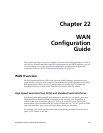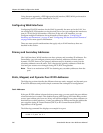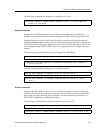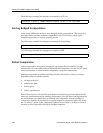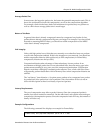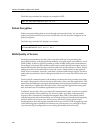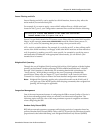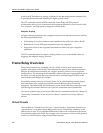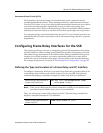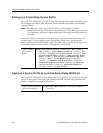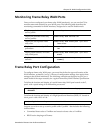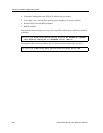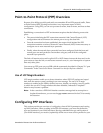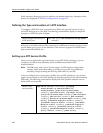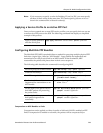
Chapter 22: WAN Configuration Guide
322 SmartSwitch Router User Reference Manual
works with IP Precedence or priority, as defined in the qos configuration command line,
to provide preferential traffic handling for higher-priority traffic.
The CLI commands related to RED in both the Frame Relay and PPP protocol
environments allow you to set maximum and minimum threshold values for each of the
low-, medium-, and high-priority categories of WAN traffic.
Adaptive Shaping
Adaptive shaping implements the congestion-sensitive rate adjustment function and has
the following characteristics:
• No blocking of data flow under normal condition if the traffic rate is below Bc+Be
• Reduction to a lower CIR upon detection of network congestion
• Progressive return to the negotiated information transfer rate upon congestion
abatement
The CLI command related to adaptive shaping allows you to set threshold values for
triggering the adaptive shaping function.
Frame Relay Overview
Frame relay interfaces are commonly used in a WAN to link several remote routers
together via a single central switch. This eliminates the need to have direct connections
between all of the remote members of a complex network, such as a host of corporate
satellite offices. The advantage that Frame Relay offers to this type of geographic layout is
the ability to switch packet data across the interfaces of different types of devices like
switch-routers and bridges, for example.
Frame Relay employs the use of Virtual Circuits (VCs) when handling multiple logical
data connections over a single physical link between different pieces of network
equipment. The Frame Relay environment, by nature, deals with these connections quite
well through its extremely efficient use of precious (sometimes scarce) bandwidth.
You can set up frame relay ports on your SSR with the commands described in Chapter 15:
“frame-relay Commands” in the SmartSwitch Router Command Line Interface Reference
Manual.
Virtual Circuits
You can think of a Virtual Circuit (VC) as a “virtual interface” (sometimes referred to as
“sub-interfaces”) over which Frame Relay traffic travels. Frame Relay interfaces on the
SSR use one or more VCs to establish bidirectional, end-to-end connections with remote
end points throughout the WAN. For example, you can connect a series of multi-protocol
routers in various locations using a Frame Relay network.




